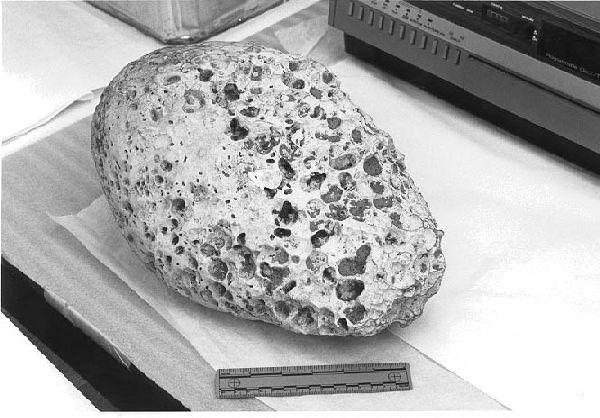Ballast Stones
 Ballast stones, whose weight stabilized empty ships, have been found at various colonial landing sites along the North Carolina coast. Although there are no known records, residents and local historians believe that these stones, found in coastal counties along the shore and under water, were used as ballast in early sailing vessels. In the colonies, the market for manufactured goods from abroad was limited, but local produce such as lumber, naval stores, grain, and tobacco was exported from North Carolina. On the westbound voyage, ships needed weight to lower them in the water to keep them from capsizing; large stones filled the ships' hold, but after they arrived this ballast was thrown overboard to be replaced by products from the colony.
Ballast stones, whose weight stabilized empty ships, have been found at various colonial landing sites along the North Carolina coast. Although there are no known records, residents and local historians believe that these stones, found in coastal counties along the shore and under water, were used as ballast in early sailing vessels. In the colonies, the market for manufactured goods from abroad was limited, but local produce such as lumber, naval stores, grain, and tobacco was exported from North Carolina. On the westbound voyage, ships needed weight to lower them in the water to keep them from capsizing; large stones filled the ships' hold, but after they arrived this ballast was thrown overboard to be replaced by products from the colony.
Jettisoned stones began to clog the harbors so badly that in 1769 North Carolina political leader Richard Caswell presented a bill in the colonial Assembly to appoint a ballast master who would regulate this activity in the vicinity of Ocracoke Inlet. The problem persisted, however, and in 1784 the General Assembly passed an act that prohibited ballast stones from being thrown into the channel of the Cape Fear River. Thereafter, before docking, ships were required to dispose of their ballast prior to reaching the low watermark. Stones left in shallower water undoubtedly provided the cobblestones still seen in some of the streets along the river in Wilmington.
References:
Walter Clark, ed., State Records of North Carolina, vol. 24 (1905).
C. Christopher Crittenden, The Commerce of North Carolina, 1763-1789 (1936).
Additional Resources:
Burdette, Kemp Magnus Wilkes and Smith, Michael S. "The Mineralogy, Petrology, and Provenance of Ballast Stones From The Cape Fear, North Carolina: 1725 - 1825." In review Journal of Historical Archaeology.
Burdette, Kemp M. and Smith, Michael S. (2003). "The introduction and use of ballast stones in the Cape Fear Region: An underutilized tool for archaeologist and historians." Honor's thesis, University of North Carolina at Wilmington.
Miller, J. William. "Ballast Stone Studies From North Carolina Shipwreck 003bui, The Queen Anne’s Revenge: Mössbauer Spectroscopy" Southeastern Geology 40, No. 1. February 2001, p. 59-64 http://wayback.archive-it.org/org-67/20120515001830/http://www.qaronline.org/rcorner/Millerscreen.pdf
Callahan, John E. "Ballast Stone Studies From North Carolina Shipwreck 0003 Bui, The Queen Anne’s Revenge: Hand Specimen, X-Ray, Petrographic, Chemical, Paramagnetic and 40K - 40Ar Age Results." Southeastern Geology 40, No. 1, February 2001, p. 49-57. http://wayback.archive-it.org/org-67/20120515001828/http://www.qaronline.org/rcorner/Callahanscreen.pdf
Image Credits:
Photograph of "Stone Fragment Accession #: H.1914.13.1" North Carolina Museum of History.
1 January 2006 | Powell, William S.